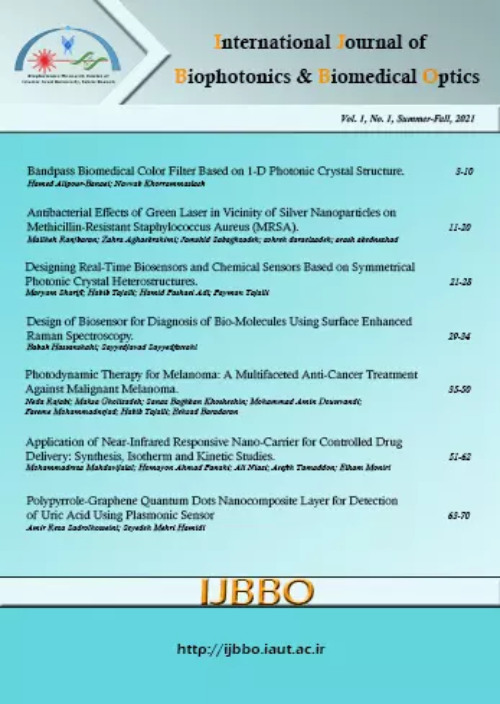فهرست مطالب

International Journal of Biophotonics and Biomedical Optics
Volume:1 Issue: 1, Winter and Spring 2021
- تاریخ انتشار: 1401/10/07
- تعداد عناوین: 7
-
Pages 3-10
We propose a flexible design for tunable bandpass biomedical color filter based on one-dimensional photonic crystals with introducing defect layers into one dimensional periodic structure which permits localized modes to exist with frequency inside photonic band gap (PBG). In the proposed structure we can tune localized modes for manifesting different colors by selecting a specific wavelength in the visible light spectrum and also we tuned localized modes in PBG for RGB wavelengths applicable in biomedical systems. With changing the defect layer refractive index, the tuning of the frequency has been done and therefore this structure is suitable for optical biomedical bandpass filter.
Keywords: Photonic Crystal, Color Filter, Photonic Band Gap, RGB Colors, Biomedical Systems -
Pages 11-19
Methicillin-resistant Staphylococcus aureus (MRSA) is a type of staph bacteria that is resistant to most of the available antibiotics. So different methods have been introduced to overcome this great threat to public health. Photoactivated metal nanoparticles have been presented as good alternatives to antibiotics. In this paper, S. aureus ATCC 33591 as reference strains and clinical MRSA bacteria, isolated from wounds of burn patients, was used. After identification of the bacteria and testing its antibiotic susceptibility, the minimum inhibitory concentration test was performed to study the antibacterial effect of Ag-NPs on MRSA. Our results showed that the bacterial colony population of both samples of S. aureus strains was reduced significantly in the presence of Ag-NPs. The antibacterial effect was enhanced by utilizing a green laser. Interestingly, the bacterial growth has completely inhibited after 2 minutes of laser irradiation in the BHI agar medium. Also, in the nutrient agar medium and Müller-Hinton agar medium, significant synergistic bacterial suppression has been observed by combination the antibacterial effects of the laser and the Ag-Nps.
Keywords: Antibacterial activity, Green laser, Methicillin-resistant S. aureus (MRSA), Oxygen species, Silver nanoparticles -
Pages 21-28
In this paper, we introduce and analytically demonstrate a novel biosensor based on the light-matter interaction in a classic topological photonic crystal (PC) heterostructure, which consists of two opposite-facing 5-period PCs separated by a microfluidic channel. Because of the excitation of topological edge mode (TEM) at the interface of the two PCs, the strong coupling between incident light and TEM produces a high-quality resonance peak, which can be used to detect very small changes in the refractive index of biomaterials such as Jurkat Cells inside the microfluidic channel. The proposed biosensor has a sensitivity as high as 240 nm/RIU and figure of merit (FOM) higher than 250.
Keywords: Biosensor, Photonic Crystals, Topological Edge Modes, Light-Matter interaction, Transfer Matrix Method -
Pages 29-34
In recent years, surface enhanced Raman Spectroscopy (SERS) method have been applied in the area of biotechnology, nanotechnology and diagnostic issues. For that, nanoparticles have been arranged near the flat film structure. By doing so, it is found that the local field enhancement can be greatly improved. In this paper, using two type of nanoparticles namely Ag, Au, we have obtained a double resonance system structure. The process is carried out by the application of nanoparticles, Ag and Au with Ag as a grating coupler. The space and interspace of 3 nm and 5-20 nm for the two particles Au and Ag are considered, respectively. A double resonance system structure has been proposed and simulated with the LUMERICAL FDTD. Our result show that for nanoparticle-film coupling, the highest enhancement factor of 〖(10〗^13) can be obtained for Ag nanosphere and Ag-grating coupler. Finally the simulation results show that application of multiple couplings associated with Ag grating filed and tooth like binding of Ag grating coupling can be used to significantly improve the near-field enhancement.
Keywords: nano-particle, Raman spectroscopy, FDTD, Nano structure, Plasmonic -
Pages 35-49
The treatment of patients with malignant melanoma remains complex and unsatisfactory. Conventional treatment strategies have been approximately ineffective. Dacarbazine (DTIC) is identified as one of the most effective chemotherapy drugs against melanoma with a response rate of around 15–20%. Numerous patients with melanoma who primarily respond to surgery subsequently relapse. Obviously, there is an essential need for better identification, and the improvement of potential treatments is warranted. One such treatment is photodynamic therapy (PDT), in which an agent (photosensitizer, PS) produces reactive oxygen species (ROS) post-irradiation of cancer cells (containing PS). This study reviews the current discovered potential of PDT and their combinations in treating metastatic melanoma and discusses the impact of different PDT strategies on this cancer. Based on different studies, we realize that PDT at different strategies has shown powerful anti-cancer effects on reducing cell viability, metastasis ability, and the induction of apoptosis in different types of melanomas (in vitro and/or in vivo studies). Importantly, promising outcomes have been reported in the reduction of recurrence rate after PDT-treatment. Also, PDT is a manageable therapeutic approach that may offer an additional powerful option for adjuvant therapy of patients with melanoma.
Keywords: Malignant melanoma, Photodynamic therapy, Adjuvant therapy, Metastasis, Apoptosis -
Pages 51-61
Due to the importance of selecting an appropriate strategy in drug delivery systems, numerous studies have been performed to support this process. However, there are still major obstacles associated with the targeted drug delivery to cancer tissues. Hence, the main focus of this study is to develop the current cancer therapies by using drug delivery systems. To achieve this goal, we have synthesized a near-infrared light responsive drug carrier based on WS2 nano-sheets, which can be a good candidate for applications such as drug delivery vehicle and chemo-photothermal treatments. In this study, a rapid and economy synthesis method was employed to modify the nano-sheets of WS2 for targeted drug delivery of bicalutamide as a prostate anti-cancer drug. The investigation of adsorption isotherm was fitted well by Langmuir model (qmax = 15.87 mg g-1). The evaluation of adsorption kinetic was better expressed by pseudo-second-order kinetic model (R2=0.9998). In-vitro drug release study was performed more rapid and complete in simulated blood fluid (pH=7.4) at 50°C than 37°C. Besides, the activity of the produced nano-carrier was examined under near-infrared light irradiation (at 808 nm). The drug release data were investigated through Zero-order, First-order, Higuchi, Hixson-Crowell and Korsmeyer–Peppas mathematical models.
Keywords: Thermo-sensitive polymer, Drug delivery, Bicalutamide, In-vitro drug release, WS2 nano-sheets, Near-infrared light irradiation -
Pages 63-70
A polypyrrole-graphene quantum dots nanocomposite layer was prepared on the surface of the gold layer for detection of the uric acid using the surface plasmon resonance technique. The X-ray diffraction spectrum and the field emission scanning electron microscopy image for polypyrrole-graphene quantum dots layer confirmed the graphene quantum dots scattered on the surface of the polymer and the nanocomposite layer formed on the surface of thin gold layer in the thickness of 13.3 nm. The minimum concentration of uric acid that was detected by the sensing layer was about 1 ppm and the affinity constant of polypyrrole-graphene quantum dots for detection of uric acid was larger than the affinity constant for detection of ascorbic acid and glucose. The response of the polypyrrole-graphene quantum dots is larger than the response of polypyrrole for the detection of uric acid.
Keywords: Surface plasmon resonance, polypyrrole-graphene quantum dots, uric acid, glucose, ascorbic acid


